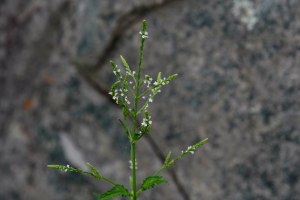It’s ten o’clock Monday morning, and although the temperature is only about 82 °F on the Billy Goat B trail, I’m pouring sweat from the high humidity.
Fortunately, there’s a nice breeze blowing to keep me cool.
Hiker Elizabeth with her sixteen pound daypack loves it.
Photographer Elizabeth, trying to get nice flower pics, is deeply annoyed.
Seemed like I couldn’t get good pictures of anything. I had gone to shoot enchanter’s nightshade, a medium-sized, shade-loving forb with a wispy stem and tiny flowers, easily moved by the breeze.
The flower has an unusual structure, with only two petals, so deeply cleft that they appear to be four, two sepals, two stamens, one style, and an inferior ovary.
Other plants currently blooming include:
- fringed loosestrife (Lysimachia ciliata)
- white avens (Geum canadense)
- trumpet creeper (Campsis radicans)
- honewort (Cryptotaenia canadensis)
- bottlebrush grass (Elymus hystrix)
- water willow (Justicia americana)
- lizard’s tail (Saururus cernuus)
- blue-eyed grass (Sisyrinchium angustifolium)
- common cattail (Typha latifolia)
- and even a few goldenrod! (Solidago species)













